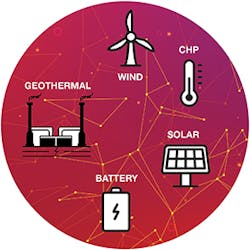Technological synergies make equipment working in harmony more efficient, cost-effective, and profitable.
Today, as the world moves toward increasingly decentralized power systems, an ever-growing number of architectures are combining solar, wind, geothermal energy, CHP, gas-fired generation, and energy storage. These hybridized systems are utilizing the attributes of each power source to effectively boost power capacity and smooth electrical output.
Analysts explain that this strategy of wiring together disparate technologies is becoming more attractive to both power providers and energy consumers. In fact, Wood Mackenzie forecasts that as much as 35 GW of renewables-plus-storage installations will be built by the end of 2021 alone, driven by the promise of “resource complementarity,” greater system efficiency, and the ability to match production to demand.
This rise in installations integrating energy resources suggests the dawn of a new era for power production and distribution. Riccardo Amoroso, head of the innovation and product lab at Enel X, sees hybridized systems as a solution to “fill in the spaces” between intermittent energy resources, provide flexibility with storage and energy management, and bridge customer relations.
As companies look ahead toward a decentralized energy future, in which electrification provides enhanced productivity, decarbonized solutions, increased intelligence, and responsiveness, they are finding success with collaborative technologies and the development of next-generation projects.
In the US, Enel Green Power has coupled geothermal and solar generation resources with energy storage in its 35-MW Stillwater development. GE’s Wind Integrated Solar Energy technology platform runs a number of hybrid projects including a 1.6-MW wind/223-kW PV installation in Anantapur, India, and two in Minnesota. Vestas, a Danish turbine maker, completed the world’s first utility-scale wind, solar, and battery storage project—its 60.2-MW Kennedy Energy Park Phase 1 development in Australia.
“Reliable access to firm—and ideally load-following—renewable energy production is what developers are after, and you won’t get that with standalone wind or solar,” explained GE Renewable Energy global strategic growth leader Amelie Wulff.
In this issue of Distributed Energy, we celebrate complementary technologies—equipment and architectures that optimize efficiency and performance. We recognize these partnerships as the future of energy and evidence of the advancement to a more flexible, more intelligent energy architecture.
In “A New Team of Horses,” we explore the symbiotic relationship between microgrids and combined heat and power (CHP) technologies. CHP units that generate power and capture waste heat for use can often form the keystone of small-scale power distribution networks. These paired technologies work together as an efficient and profitable team.
In “Energy Storage for Demand Response,” we outline several applications of energy storage used to supply power when the utility needs to adjust energy output in relation to customer need. In many of the applications profiled—including one in a Finnish shopping center that uses PV panels to generate solar power for onsite use and time-shifting to reduce grid charges—we see that energy storage offers both affordability and flexibility.
In “Tapping Tanks for Energy Storage,” we take a close look at phase change technology. Cooling water in tanks during off-peak hours creates virtual batteries. These can be installed in a modular fashion, have zero cycling issues, and have a lifespan of over 25 years, as one deployment at JCPenney’s corporate headquarters demonstrates.
Today’s sensors, metering technology, software, and analytics are effectively working together to make the grid smarter and more responsive. In “A Two-Way Street,” we explore the complex coordination of technologies enabling enhanced communication between power utilities and consumers in smart grid systems that provide unprecedented levels of responsiveness and efficiency.
As energy architectures modernize to serve new objectives —integrating diverse power outputs and data streams—it becomes increasingly important to rethink traditional configurations and develop systems that utilize the best attributes of diverse power sources. Technological synergies such as these can make our energy future more flexible, sustainable, and resilient.
